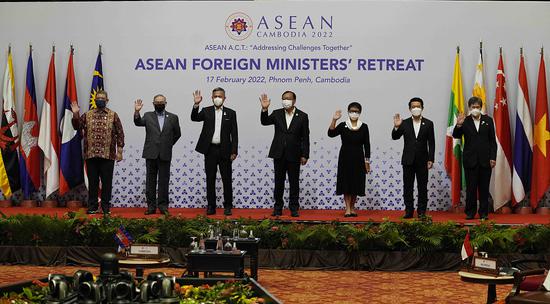Rethinking ASEAN ties with U.S., signs of another Cold War may be in the air
Editor's note: The author Bobby M. Tuazon is the director for policy studies of a Philippine think tank, Center for People Empowerment in Governance (CenPEG), and a professor at the University of the Philippines. He is also an editor and co-author of 15 books. The article only reflects the author's opinions.
It is correct that U.S. President Joe Biden's invitation to the Association of Southeast Asian Nations (ASEAN) for a summit at the White House on March 28-29 was postponed, supposedly due to conflicting schedules. However, a keen observer will agree that the gathering had no clear agenda in the first place, except to surmise that Biden probably wanted the ASEAN leaders to commit themselves to supporting economic sanctions on Russia in response to what Western countries describe as Moscow's unprovoked aggression toward Ukraine. That would have been the last thing the ASEAN governments would want, given their disinclination to be involved in the Russia-Ukraine conflict.
At the moment, ASEAN and Russia are big trade partners. Underscoring the importance of their relations, the two sides signed the ASEAN-Russia Trade and Investment Cooperation Roadmap in 2021 and held an economic summit last October. The regional association's 10 member countries view their increasing economic ties with Russia as vital and have the same view regarding their vibrant economic relations with China.
In contrast, ASEAN countries view their relations with the U.S. with circumspection. The roadmap that defines the U.S.' dealing with the regional group is primarily security in the context of Washington's confrontational policy toward Beijing. Since the start of the Biden presidency in 2021, it has been conspicuous that the U.S.' foreign policy in the region is to coax ASEAN to support a united front against China. This route is clearly indicated by strengthening its defense alliances or military cooperation with countries in the region, such as the Philippines, Singapore, and Vietnam.
Since last year, a flurry of senior U.S. officials have visited the region, including Vice President Kamala Harris, who visited Singapore and Vietnam; Defense Secretary Lloyd Austin, who visited Singapore, the Philippines and Vietnam; Deputy Secretary of State Wendy Sherman, Indonesia, Cambodia and Thailand; Assistant Secretary of State for East Asia Daniel Kritenbrink, Malaysia, Indonesia, Singapore and Thailand; and Secretary of State Antony Blinken, who visited Indonesia and Malaysia. In these official visits, the top U.S. officials pledged to make America's traditional commitments enduring, but the inflection was clearly to secure deeper security commitments from those countries.
The U.S. continues to drum up support for its new security strategy and alliances under its geostrategic containment plan for China. Begun by former president Donald Trump, the Indo-Pacific Strategy, for instance, seeks to build a strategic partnership between the U.S. and India in the guise of promoting stability in South China. On the other hand, the Quadrilateral Security Dialogue (Quad), dubbed a strategic dialogue, is actually geared toward building a technological alliance between the U.S., Japan, Australia and India against China. Meanwhile, Australia, the UK and the U.S. (AUKUS) complements the Quad and aims to help Australia build its nuclear weapons capability with a modern submarine fleet that will navigate the Indo-Pacific and the South China Sea.
These all-spectrum military initiatives are clearly designed by the U.S. to raise its level of encirclement against China to the extent of restricting its movements and strangling trade routes critical to Beijing's economic growth.
The security-centric paradigm that has long guided American thinking is a narrow lens through which to view and understand the region. Irrational military diplomacy will not work. It will all the more force many countries in Asia, including those in Southeast Asia, to distance themselves from a track that will bring them into direct collision with China. For that matter, India is now rethinking whether to remain a dialogue partner in the Quad after seeing what Indian scholars call American arrogance in coercing the New Delhi government to support U.S. sanctions on Russia, a long-time, traditional ally.
The ASEAN economic bloc is China's largest trading partner in the region. ASEAN and China are also part of the world's biggest free trade agreement, covering nearly 30 percent of the global economy under the Regional Comprehensive Economic Partnership, which the U.S. is not part of. Moreover, the U.S. has also been left out of the Comprehensive and Progressive Agreement for Trans-Pacific Partnership, a free trade agreement formerly known as the Trans-Pacific Partnership.
These are ground realities that the Biden administration refuses to believe. This is not surprising in light of the fact that the Biden foreign policy team is impeded by neoconservatives led by State Secretary Antony Blinken and Kurt Campbell, Biden's point person for Indo-Pacific, who co-founded the Center for a New American Security (CNAS). Like the corporate affiliations of key cabinet members, CNAS has links to war industries. For decades now, the powerful U.S. military-industrial complex has been behind the U.S.' confrontational policy with China and NATO's military eastward expansion to Russia, which led to the Ukraine crisis. Indeed, the Ukraine crisis has seen a surge in major aerospace and defense company shares, as have the defense budgets of the U.S. and its NATO allies.
As in the rest of the world, the Southeast Asian region will see more of this in the years ahead. The world has become more complex, and signs of another Cold War are in the air.

